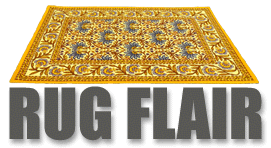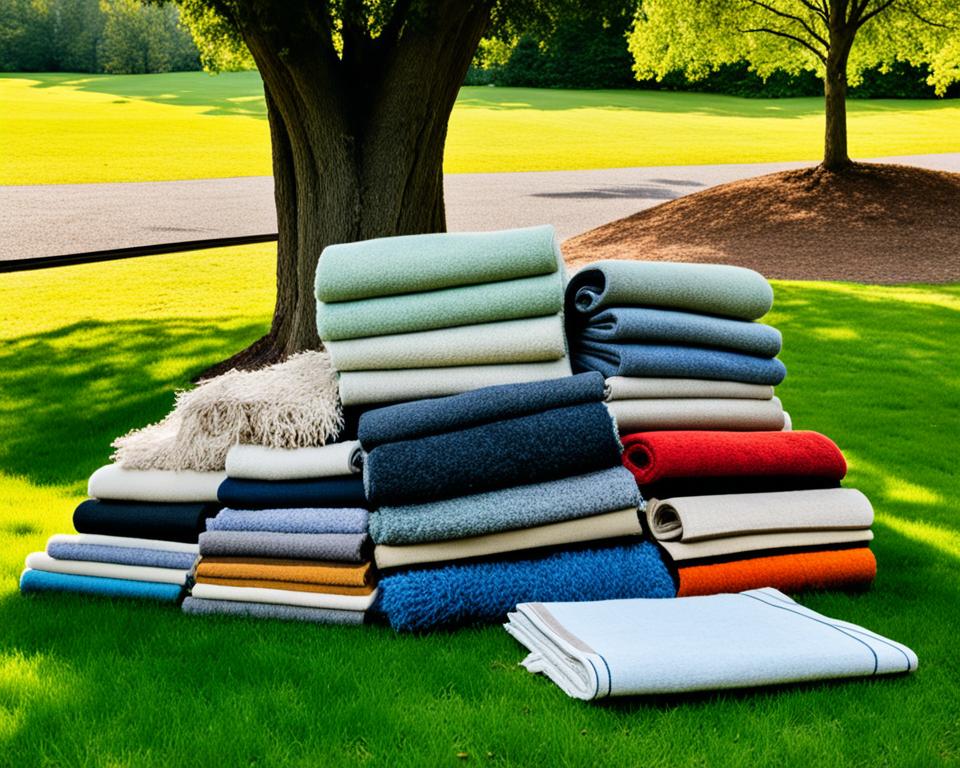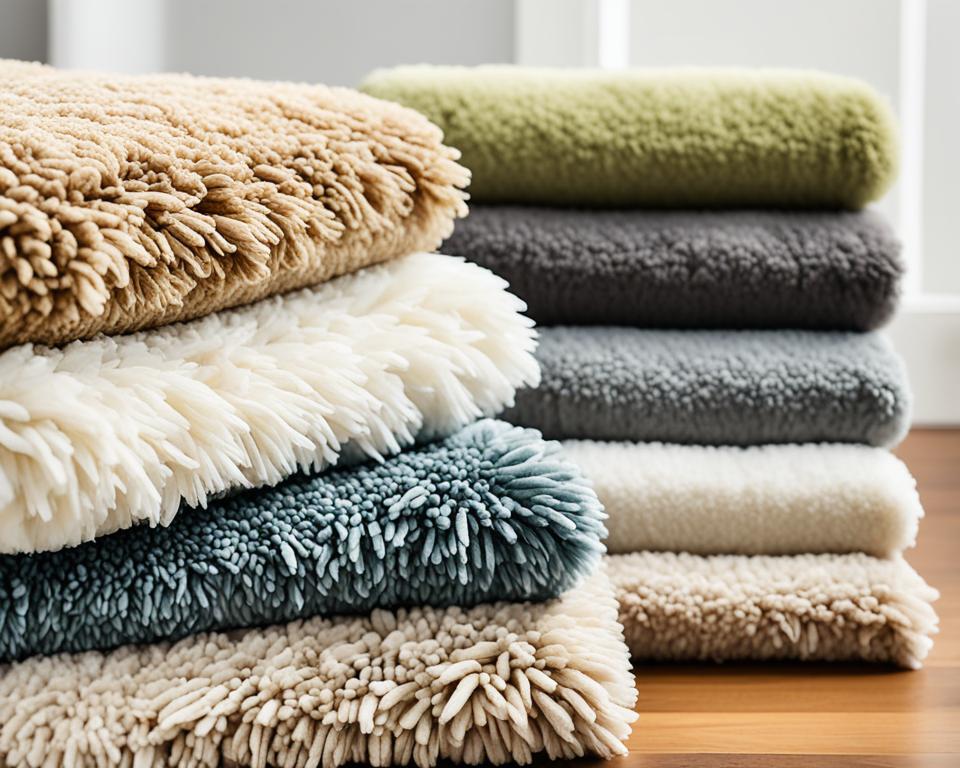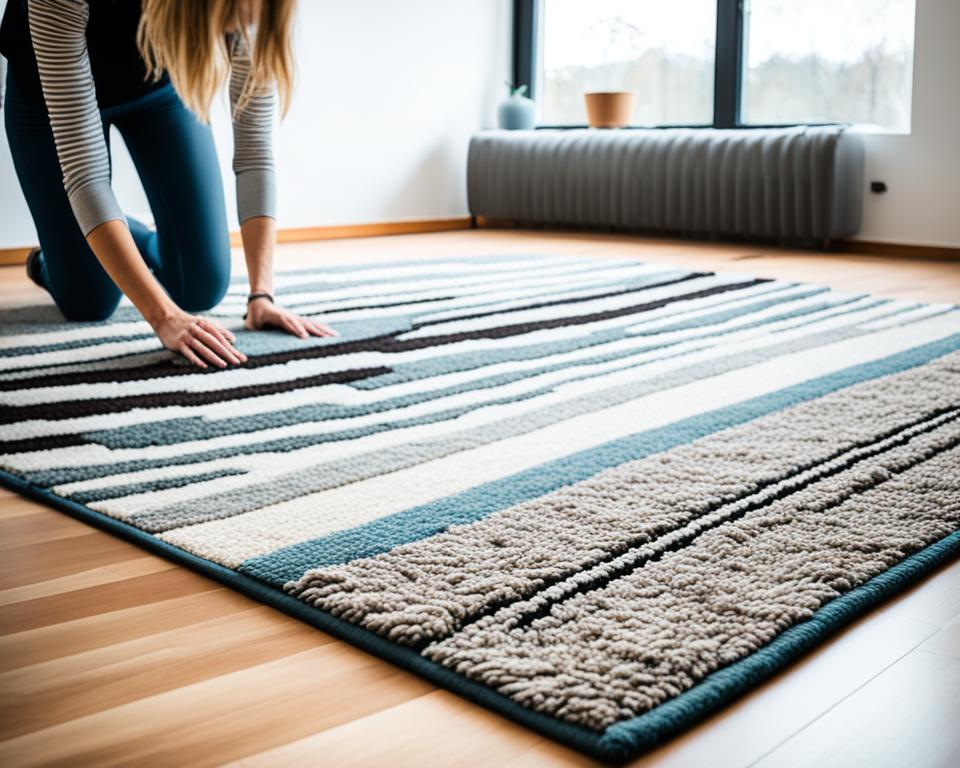Have you ever pondered the fate of old carpets and rugs once they’ve completed their tenure gracing your floors or serving diligently in high-traffic business areas? The reality is that while your home might harbor the same cozy rug for years on end, businesses replace carpets regularly due to increased footfall, contributing significantly to waste management challenges. Yet, the question remains: can rugs be recycled? The answer is a resounding yes, albeit not without its complexities.
In the vast ecosystem of waste, recycling rugs stands out as a pertinent topic. In the United States, a massive volume of carpet waste makes its way to our landfills each year, a fraction of which sees a new life through recycling efforts. Understanding how to partake in sustainable rug disposal practices is not just beneficial; it’s essential to steering our planet towards a greener future. Curious about the know-how? This guide is replete with rug recycling tips to navigate this environmental imperative successfully.
Whether you’re a homeowner looking to update your living space or a business with worn carpets begging for replacement, there’s an eco-friendly solution within your grasp. With the right approach, you’ll find that transforming old carpets from potential waste to worthy candidates for recycling is entirely within the realm of possibility. So, let’s roll up our sleeves and discover how you can contribute to recycling rugs effectively. It’s time for your old rugs to embark on an exciting new journey!
Key Takeaways
- Most carpets and rugs can be recycled, despite their complex constructions.
- Recycling reduces the volume of carpet waste ending up in landfills or being incinerated.
- Eco-friendly disposal prevents environmental pollution from toxic waste and greenhouse emissions.
- Sustainable rug disposal is achievable through local government recycling programs and private facilities.
- Businesses can significantly benefit from partnering with eco-conscious waste management companies.
- Rug recycling processes involve advanced sorting techniques and the transformation of old materials into valuable new products.
The Importance of Eco-Conscious Rug Disposal
When it comes to replacing your cozy home rugs or the well-trodden carpets of your bustling business, understanding the environmental ramifications of their disposal is crucial. As you’ll find, the significance of environmentally friendly rug disposal extends far beyond simply clearing space – it involves taking responsibility for the planet’s future. Let’s delve into the often-unseen impacts of carpet waste and explore why recycling old rugs is more than just a good deed; it’s a necessity for sustainable living.
Understanding the Volume of Rug Waste
In a single year, the amount of carpet and rug waste the U.S. produces is staggering – think millions of tons, with only a fraction being redirected from landfills through rug waste management strategies such as recycling. This is a sizable environmental challenge, as each unwanted carpet carries the potential for lasting impacts. Here’s a more detailed look at the numbers that make the case for eco-conscious disposal methods.
| Year | Carpet and Rug Waste (in tons) | Recycled (in tons) | Sent to Landfill (in tons) | Incinerated (in tons) |
|---|---|---|---|---|
| 2018 | 3,400,000 | 310,000 | 2,460,000 | 600,000 |
Longevity of Rugs in Landfills and Its Effects
It’s not just the volume; it’s the lifespan of these rugs in landfills that poses a concern. Synthetic materials and complex weaves contribute to a protracted breakdown process. Over time, piled-up rugs can release harmful chemicals, joining the chorus of microplastics polluting our environment. These revelations underscore the urgent need to amplify efforts in recycling old rugs, highlighting the critical role this plays in our quest for a more sustainable living environment.
- Synthetic rug materials take hundreds of years to decompose.
- Rugs in landfills contribute to hazardous emissions and chemical leaching.
- Increased rug recycling helps to curb microplastic pollution.
What Are Carpets and Rugs Made Of?
As you begin to explore the world of home decor, particularly carpeting, understanding the carpet construction components becomes vital. It’s not just about picking a color or texture—knowing what goes beneath your feet can help you make more informed choices and appreciate the durability and comfort offered by modern carpeting.
Breaking Down the Components of Carpet Construction
The core structure of a carpet plays a hidden yet critical role in its overall performance. Commonly found in homes across the United States, carpets and rugs are typically composed of a multi-layered design, evident in their intrinsic durability and lasting power. The composition of these layers is crafted to meet the demands of daily wear and lends carpets their texture and toughness.
| Carpet Layer | Material Used | Common Types | Attributes |
|---|---|---|---|
| Face Fiber | Synthetic Fibers | Nylon, Polypropylene, Polyester, Acrylic | Durability, Stain Resistance |
| Primary Backing | Support Material | Polypropylene (PP) | Stability, Foundation for Fibers |
| Secondary Backing | Strengthening Material | Polyvinyl Chloride (PVC) | Added Durability, Shape Retention |
Each layer, from the face fiber to the backings, aims to enhance the overall carpet experience. Whether it’s the plastic-based fibers in carpets that resist stains or the substantive backings that maintain the carpet’s structural integrity, they all contribute to a well-designed rug’s lifespan.
The Predominance of Plastic in Rug Manufacturing
Stepping into the realm of materials, we uncover the dominance of synthetics in the industry. Synthetic rug materials like nylon, noted for their resilience and longevity, are preferred for the most trod-upon layer, the face fiber. It is astounding to realize that plastic-based fibers grace almost every corner of the modern home, swathed over floors that play host to life’s daily moments.
Why such a strong allegiance to plastics in the carpet universe? The reasons are multi-fold—affordability, longevity, and a solid performance track record make materials like nylon, polypropylene, polyester, and acrylic the go-to choices for designers and homeowners alike.
Despite the allure of natural fibers such as wool, known for their sumptuous feel and superior quality, the higher cost often places them as a secondary option for consumers. The market’s inclination leans toward synthetic options — a decision that frequently intertwines considerations of economics with practicality.
In your pursuit of the perfect rug, keep these components in mind. They are not merely layers and materials, but the foundation of comfort and style in your celebrations, quiet moments, and every step you take within your abode.
The Environmental Toll of Improper Rug Disposal
The comforts of a well-adorned floor are undeniable, yet seldom do we ponder the environmental impact of rug disposal once their utility fades away. The consistent accumulation of carpet waste hazards emphasizes an urgent need for eco-conscious rug disposal practices. But what are the tangible repercussions of mishandling the farewell of these woven adornments?
Unequivocally, the improper disposal of rugs is not a benign oversight but a serious environmental misstep. It is imperative for consumers and businesses alike to acknowledge the considerable toll these once-cherished items can have on the environment when they fall victim to neglectful end-of-life disposal practices.
The Hazards of Carpet Waste in Landfills
When old rugs meet the somber fate of landing in our landfills, their decomposition becomes a centuries-long saga. These remnants of domestic tranquility and commercial buzz can become staunch eco-adversaries, threatening to release noxious substances into the Earth’s soil and water sources. The reality behind carpet waste hazards reverberates through the timelines of our ecosystems, as these buried artifacts obstinately persist in the ground.
“The hidden adversaries in our landfills are carpets, harboring toxins that silently leach into the earth, bidding their long-term defiance to decomposition.”
It’s a troubling paradox to witness enduring resilience transformed into an ecological burden. Your role in mitigating these effects starts with informed choices and committed actions towards sustainable rug disposal.
Carpet Incineration and Air Quality Concerns
Alternatives to landfill, such as incineration, may appear as a deceptive panacea to the burgeoning mounds of unwanted rugs. However, this method ushers a spectrum of other vilifications – the compromise of air quality and carpet incineration. As these textiles are consumed by flames, they birth aerial poisons that infiltrate the breath of life surrounding us – manifesting as greenhouse gases and sinister pollutants.
In such light, the paramountcy of eco-friendly disposal choices emerges clearer than ever. Ensuring that the legacy of your cherished carpets doesn’t include a narrative of environmental degradation calls for a conscientious engagement with sustainable rug disposal avenues.
Standing at the crossroads of convenience and responsibility, your active pursuit of knowledge and options in disposing of carpets can significantly abate these pressing environmental concerns. Rug disposal isn’t just a mundane task, but a meaningful stride toward preserving the sanctity of our environment for generations to come.
Can Rugs Be Recycled? Unveiling the Possibilities
As you plan to update your living space or revamp your office, no doubt you’ve pondered, how to recycle rugs. Despite a common misconception, most rugs aren’t destined for the landfill—they can embark on a second life through proper recycling. Let’s unwrap the rug recycling process and explore eco-friendly rug disposal options that are both available and beneficial for your home and our planet.
Confronted with a wealth of materials, rug recycling demands a precise identification system. Thanks to technological advancements, spectrometry plays a pivotal role in determining the exact components of your rug. This accurate identification is essential because each material commands a different recycling approach. Once the constituents of your rug are discerned, mechanical separation follows, which systematically disassembles the fibers and backings.
Here’s a glimpse into what happens when your rug reaches a recycling facility:
- Sorting of materials using advanced spectrometry
- Physical separation of fibers, backings, and adhesives
- Processing separated materials for repurposing or upcycling
In the heat of the recycling process, fibers like polypropylene might find a new purpose when melted down into pellets, whereas nylon could be rejuvenated into fresh carpeting or other products. This transformative journey beckons a positive environmental impact, dispelling the myth that rugs are non-recyclable and reinforcing that eco-friendly rug disposal is an attainable goal.
Rug recycling not only exemplifies the spirit of sustainability but also reduces the demand for virgin materials, thereby lessening our carbon footprint. If you’re ready to contribute to a healthful environment, seek out local carpet recycling facilities or initiatives. Don’t hesitate to query retailers or manufacturers—as they might have take-back programs, making your journey to eco-friendly rug disposal all the smoother.
Check out the table below to better understand the materials generally found in rugs and their respective recyclability possibilities:
| Rug Material | Common Presence in Rugs | Recyclability |
|---|---|---|
| Nylon | Common in residential and commercial rugs | Highly recyclable into new carpeting |
| Polypropylene | Widely used due to its sturdiness | Can be melted down into plastic pellets |
| Polyester | Frequent in various rug types | Recyclable, often into fiberfill or fabric |
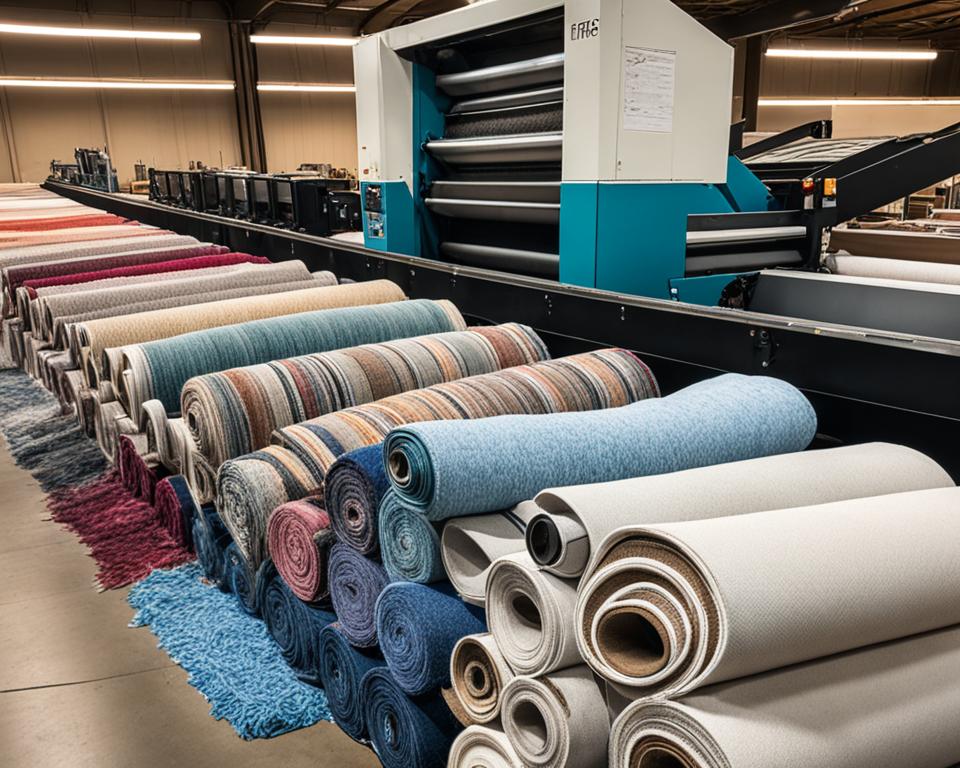
Approaching rug disposal with an informed perspective can dramatically decrease environmental harm while underlining your role in fostering a circular economy. Now that you’re equipped with the knowledge, you can take pride in making informed choices for eco-friendly rug disposal options that resonate with your sustainable living values.
Sustainable Rug Disposal Options for Homeowners
As you consider updating the interiors of your home, you might be pondering the fate of your old rugs. Stepping towards a greener path involves more than just discarding these items; it’s about discovering and utilizing eco-conscious rug disposal practices. Fortunately, there are multiple sustainable avenues available for the environmentally aware homeowner. From extending the life cycle of rugs through reuse and donation to engaging with forward-thinking take-back initiatives, let’s explore how your old rug can avoid the landfill and contribute to a sustainable future.
Exploring Reuse and Donation Programs
Sometimes, a rug is removed more for aesthetic reasons than from wear and tear. If that’s the case with your rug, why not consider rug reuse and donation? Donating your gently used carpets can significantly benefit those in need, while also diverting waste from landfills. Numerous charitable organizations willingly accept home goods, and your gently loved rug could find a second home while you contribute towards reducing environmental waste.
- Local thrift stores and shelters often welcome rug donations
- Check with community centers and churches for rug reuse programs
- Online marketplaces offer platforms to gift or sell usable rugs
Carpet Take-Back Schemes and Retailer Initiatives
Another promising option for sustainable rug disposal is to seek out carpet take-back schemes. Some manufacturers are making the pledge towards sustainability by initiating programs that reclaim old carpets, saving these bulky items from ending up in waste streams. Moreover, certain retailers now provide disposal services, often with the purchase of a new rug, ensuring that your old carpet is dispatched in an eco-friendly manner.
- Reach out to rug manufacturers for details on take-back programs
- Consult with flooring retailers about eco-conscious disposal services
- Investigate whether your new rug purchase includes sustainable disposal options
Identifying and utilizing these eco-friendly rug disposal opportunities not only alleviates your environmental footprint but also fosters a culture of sustainability and responsibility. So, before you move your rug to the curb, consider these beneficial alternatives; your choice has the power to make a positive imprint on the environment.
Commercial Solutions for Environmentally Friendly Rug Disposal
As businesses continue to pursue sustainability, finding commercial rug recycling solutions can make a substantial difference in how they manage waste. The key is in forging relationships with waste management companies specializing in eco-friendly practices tailored to commercial needs.
These waste management companies often provide much more than a one-size-fits-all approach. They offer customized recycling plans to suit the specific materials that a business needs to dispose of, including old carpets and rugs. By embracing such eco-friendly business disposal practices, companies can significantly minimize their environmental footprint.
Let’s consider the practical steps you can take to integrate these solutions into your business:
- Identify a reputable partner that aligns with your sustainability goals.
- Assess the volume and type of rug waste your business generates to tailor the recycling plan.
- Implement a systematic collection and sorting process to facilitate efficient recycling.
- Educate your staff on the importance and methods of eco-friendly rug disposal.
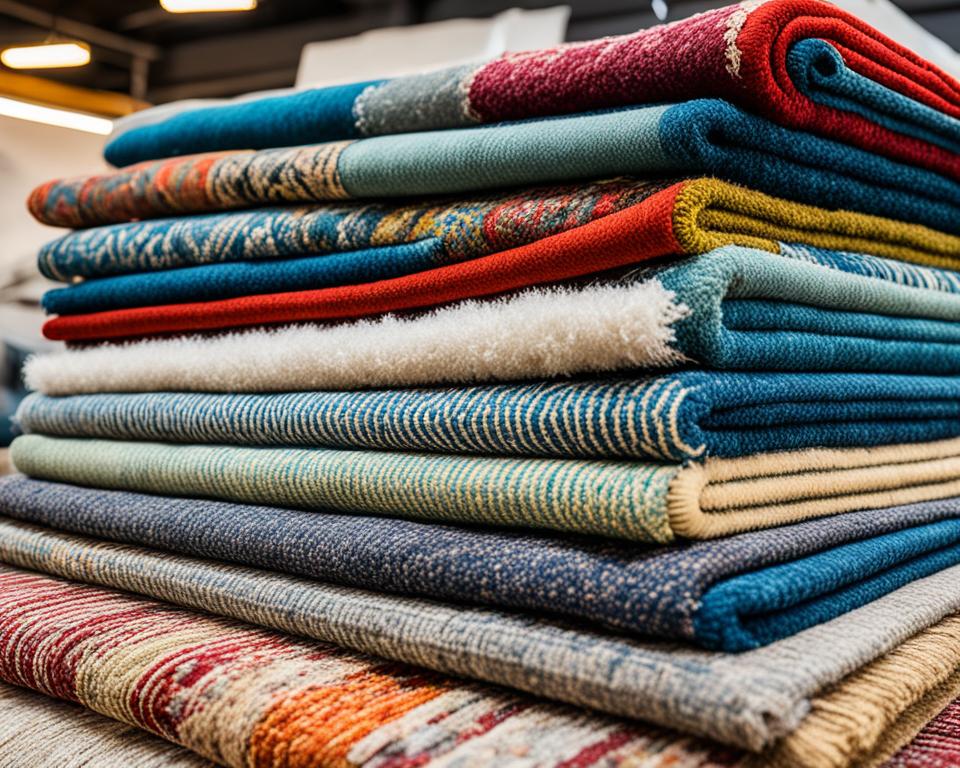
Undoubtedly, the benefits extend far beyond environmental conservation. Engaging in commercial rug recycling solutions can enhance your brand’s reputation as an eco-conscious entity and can also generate goodwill among consumers who prioritize sustainability.
Consider the impact that the pursuit of such practices can create:
| Benefit | Description |
|---|---|
| Environmental Protection | Reduction of landfill waste and preservation of natural resources. |
| Brand Image | Establishing your business as a leader in sustainability. |
| Regulatory Compliance | Adhering to state and federal recycling regulations. |
| Operational Efficiency | Streamlined waste management processes can improve overall business operations. |
Considering the insights provided here, you’re well on your path toward making a beneficial change. With your attention to commercial rug recycling solutions, you’re not only affirming a commitment to the Earth’s well-being but you’re also guiding your business towards a more sustainable and profitable future. Let the proactive adaptation of eco-friendly business disposal practices be the beacon that lights your journey to a greener horizon.
The Complexities of the Rug Recycling Process
Glimpse into the multifaceted world of rug recycling, and you’ll uncover a panorama of challenges and innovative solutions. The journey from a once-loved rug to a reincarnated resource is fraught with obstacles, largely stemming from the diversity of materials entwined in each piece. But despite these hurdles, the process of reviving old rugs into new forms is both fascinating and essential for a sustainable future.
Sorting and Identifying Rug Materials
Material sorting for recycling begins with differentiating the many fibers and substances a rug comprises. How, you might ask, do specialists discern one material from another in a mixed-fiber rug? Enter infrared spectrometry, a technological marvel that peers into the core of each thread to determine its composition. Accurately identifying these materials is the vanguard move in the recycling chess game.
After infrared spectrometry has done its detective work, mechanical separation takes the stage. This method meticulously untangles the fibers and backing from their adhesive partners, setting the stage for their next act in this upcycling ballet. Think of this machine-assisted surgery as an intricate dance where each material takes its cue, transitioning meticulously from one form to the next.
Transforming Old Rugs into New Resources
Ever wondered what becomes of nylon or polypropylene when they’ve ended their rug life? Thanks to the advances in the rug recycling process complexities, materials like polypropylene can be rekindled through melting and molding into pellets poised for rebirth. Nylon, on the other hand, might be upcycled into a vibrant new tapestry or woven into another product altogether.
As we embrace the era of circular economies, upcycling old rugs presents a plethora of resourceful avenues. Be it in turning discarded yarns into plastic lumber, automotive components, or construction materials—every fiber has the potential to play a role in a recycled masterpiece.
To ease the rug recycling process’s intricacies, a shared commitment from the industry, as well as improved collection practices, could lay down the golden thread leading to sustainability. With each step towards better sorting and recycling systems, we weave together a tapestry of environmental responsibility and innovation—a narrative where each old rug becomes part of a beautifully crafted world of sustainable materials.
Recycling Old Rugs: What Happens Behind the Scenes
Have you ever wondered about the behind-the-scenes rug recycling process? It’s a remarkable journey that transforms your well-worn area rugs into innovative new products. When you decide to participate in recycling your area rugs, you initiate a series of intricate operations that breathe new life into what was once considered waste.
The initial step in recycling old rugs is rigorous sorting. Experts scrutinize the rug to determine the type of fibers and backings it contains. This step is pivotal as it dictates the subsequent phases of recycling. Once sorted, the rug undergoes a thorough cleaning. After cleaning, it faces the shredder, which reduces it to its constituent materials. It’s during this stage of rug material reclamation that the potential for repurposing comes to light.
What emerges from this recycling rite is a treasure trove of valuable resources. Fibers may be repurposed into engineered resins that go into making a myriad of items, from car parts to the very staples of construction, like plastic lumber. It’s this cyclical economy that highlights just how transformative and impactful recycling old rugs can be. Your participation in this cycle not only supports environmental stewardship but also fosters innovation and resourcefulness within the industry.
FAQ
Can rugs be recycled?
Yes, most types of rugs can be recycled. The rug recycling process typically involves sorting the materials, breaking them down mechanically, and repurposing or processing them into new products. However, the complexity of this process depends on the materials present in the rug.
What impacts do rug waste have on the environment?
Rug waste contributes significantly to landfill mass, and because many are made from synthetic materials, they can take centuries to decompose. In landfills, rugs have the potential to release harmful chemicals and contribute to microplastic pollution. When incinerated, they can emit greenhouse gases and other toxic pollutants, negatively impacting air quality.
What are carpets and rugs typically made of?
Carpets and rugs are predominantly made of plastic materials such as nylon, polypropylene, polyester, and acrylic. These synthetic fibers are chosen for their durability and affordability. The construction of a carpet usually has a face fiber, primary backing, and secondary backing, often containing plastics like PVC or PP.
Why is it important to dispose of rugs in an environmentally friendly way?
Environmentally friendly disposal methods for rugs are critical to prevent long-term environmental damage. Proper disposal helps to avoid the leaching of toxic substances into the ground and reduces greenhouse gas emissions from incineration, contributing to a healthier ecosystem.
What are some sustainable rug disposal options for homeowners?
Homeowners can explore various sustainable disposal options, such as reusing or donating rugs, participating in manufacturer take-back programs, and using retailer disposal services. Additionally, contacting local recycling programs or waste management companies can provide eco-friendly ways to dispose of old rugs.
How can businesses ensure their rug disposal is environmentally friendly?
Businesses can partner with waste management companies that specialize in commercial rug recycling to develop tailored plans for sustainable rug disposal. These partnerships can facilitate a more eco-conscious approach to disposing of commercial carpet waste.
What are the complexities involved in the rug recycling process?
The rug recycling process is complex primarily due to the various materials used in rug construction. Each type of fiber and backing material may require a different method of processing. Material identification using infrared spectrometry and the mechanical separation of fibers are key steps before the materials can be recycled or transformed into new products.
What happens to rugs once they’re recycled?
Once a rug is deemed suitable for recycling, it goes through a multi-step process that includes sorting, cleaning, shredding, and separating the material. The resulting materials can be repurposed for a variety of uses, such as creating plastic lumber, auto parts, or being woven back into the carpet industry as new carpet backing or fiber material.
